

You chose your dog because something clicked the minute you set eyes on him. Or perhaps it seemed that the dog selected you and that’s what clinched the deal. Either way, you are now investing time and money in this dog, a true pal and an outstanding member of the family. Everything about him is perfect…well, almost perfect. Remember, he is a dog! For that matter, how does he think you’re doing?
UNDERSTANDING THE CANINE MINDSET
For starters, you and your dog are on different wavelengths. Your dog is similar to a toddler in that both live in the present tense only. A dog’s view of life is based primarily on cause and effect, which is similar to the old saying, “Nothing teaches a youngster to hang on like falling off the swing.” If your dog stumbles down a flight of three steps, hopefully he will walk more carefully next time, or he may just avoid the steps altogether.
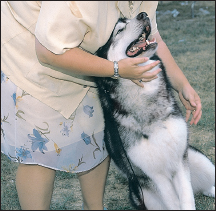
Petting a dog on the chest or underside of the neck is preferred to petting on the head or back of the neck. The latter may be perceived as dominant gestures and the dog may react fearfully or aggressively.
Your dog makes connections based on the fact that he lives in the present, so when he is doing something and you interrupt to dispense praise or a correction, a connection, positive or negative, is made. To the dog, that’s like one plus one equals two! In the same sense, it’s also easy to see that when your timing is off, you will cause an incorrect connection. The one-plus-one way of thinking is why you must never scold a dog for behavior that took place an hour, 15 minutes or even 5 seconds ago. But it is also why, when your timing is perfect, you can teach him to do all kinds of wonderful things—as soon as he has made that essential connection. What helps the process is his desire to please you and to have your approval.
There are behaviors we admire in dogs, such as friendliness and obedience, as well as those behaviors that cause problems to a varying degree. The dog owner who encounters minor behavioral problems is wise to solve them promptly or get professional help. Bad behaviors are not corrected by repeatedly shouting “No” or getting angry with the dog. Only the giving of praise and approval for good behavior lets your dog understand right from wrong. The longer a bad behavior is allowed to continue, the harder it is to overcome. A responsible breeder is often able to help. Each dog is unique, so try not to compare your dog’s behavior with your neighbor’s dog or the one you had as a child.
Have your veterinarian check the dog to see whether a behavior problem could have a physical cause. An earache or toothache, for example, could be the reason for a dog to snap at you if you were to touch his head when putting on his leash. A sharp correction from you would only increase the behavior. When a physical basis is eliminated, and if the problem is not something you understand or can cope with, ask for the name of a behavioral specialist, preferably one who is familiar with the Alaskan Malamute. Be sure to keep the breeder informed of your progress.
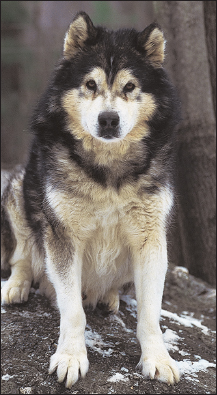
Dogs can’t talk, but can tell you a lot about themselves. The Alaskan Malamute’s intelligence and alert nature are shown clearly in the breed’s expression.
Many things, such as environment and inherited traits, form the basic behavior of a dog, just as in humans. You also must factor into his temperament the purpose for which your dog was originally bred. The major obstacle lies in the dog’s inability to explain his behavior to us in a way that we understand. The one thing you should not do is to give up and abandon your dog. Somewhere a misunderstanding has occurred but, with help and patient understanding on your part, you should be able to work out the majority of bothersome behaviors.
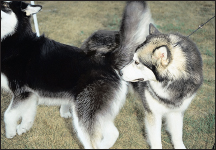
Sniffing is a dog’s way of getting to know a new canine friend. Humans often don’t comprehend the places in which dogs choose to stick their noses!
AGGRESSION
“Aggression” is a word that is often misunderstood and is sometimes even used to describe what is actually normal canine behavior. For example, it’s normal for puppies to growl when playing tug-of-war. It’s puppy talk. There are different forms of dog aggression, but all are degrees of dominance, indicating that the dog, not his master, is (or thinks he is) in control. When the dog feels that he (or his control of the situation) is threatened, he will respond. The Alaskan Malamute is a sweet-natured breed but, in all breeds, the tendency toward aggressive behavior varies with individual dogs. It is not at all pleasant to see bared teeth or to hear your dog growl or snarl, but these are signs of behavior that, if left uncorrected, can become extremely dangerous. A word of warning here: never challenge an aggressive dog. He is unpredictable and therefore unreliable to approach.
Nothing gets a “hello” from strangers on the street quicker than walking a puppy, but people should ask permission before petting your dog so you can tell him to sit in order to receive the admiring pats. If a hand comes down over the dog’s head and he shrinks back, ask the person to bring their hand up, underneath the pup’s chin. Now you’re correcting strangers, too! But if you don’t, it could make your dog afraid of strangers, which in turn can lead to fear-biting. Socialization prevents much aggression before it rears its ugly head.
The body language of an aggressive dog about to attack is clear. The dog will have a hard, steady stare. He will try to look as big as possible by standing stiff-legged, pushing out his chest, keeping his ears up and holding his tail up and steady. The hack-les on his back will rise so that a ridge of hairs stands up. This posture may include the curled lip, snarl and/or growl, or he may be silent. He looks, and definitely is, very dangerous.
HAND SHY
A puppy will shy away when a hand comes down onto his head. To the pup, this is a threatening gesture, not a welcome pat. Older dogs shy from the same hand gesture because it’s a dominant move on the part of the human. The best way to approach a dog is by crouching down and holding out your hand, palm up, for him to sniff.
This dominant posture is seen in dogs that are territorially aggressive. Deliverymen are constant victims of serious bites from such dogs. Territorial aggression is the reason you should never, ever, try to train a puppy to be a watchdog. It can escalate into this type of behavior over which you will have no control. All forms of aggression must be taken seriously and dealt with immediately. If signs of aggressive behavior continue, or grow worse, or if you are at all unsure about how to deal with your dog’s behavior, get the help of a professional.
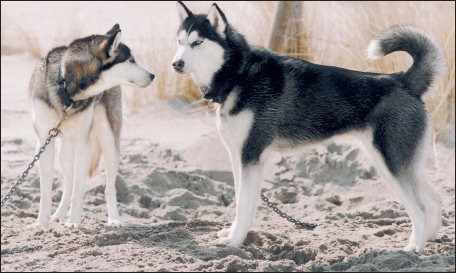
The dog pack is a community based on social status. Each dog must know his place in the hierarchy and act accordingly.
Uncontrolled aggression, sometimes called “irritable aggression,” is not something for the pet owner to try to solve. If you cannot solve your dog’s dangerous behavior with professional help, and you (quite rightly) do not wish to keep a canine time-bomb in your home, you will have some important decisions to make. Aggressive dogs often cannot be rehomed successfully, as they are dangerous and unreliable in their behavior. An aggressive dog should be dealt with only by someone who knows exactly the situation that he is getting into and has the experience, dedication and ideal living environment to attempt rehabilitating the dog, which often is not possible. In these cases, the dog ends up having to be humanely put down. Making a decision about euthanasia is not an easy undertaking for anyone, for any reason, but you cannot pass on to another home a dog that you know could cause harm.
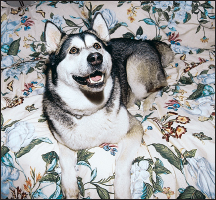
Many trainers advise owners not to allow their dogs to sleep on their beds. For potentially dominant dogs, sleeping on the master’s bed indicates equality, not a good idea when trying to establish yourself as the leader.
A milder form of aggression is the dog’s guarding anything that he perceives to be his—his food dish, his toys, his bed and/or his crate. This can be prevented if you take firm control from the start. The young puppy can and should be taught that his leader will share, but that certain rules apply. Guarding is mild aggression only in the beginning stages, and it will worsen and become dangerous if you let it.
Don’t try to snatch anything away from your puppy. Bargain for the item in question so that you can positively reinforce him when he gives it up. Punishment only results in worsening any aggressive behavior.
Many dogs extend their guarding impulse toward items they’ve stolen. The dog figures, “If I have it, it’s mine!” (Some ill-behaved kids have similar tendencies.) An angry confrontation will only increase the dog’s aggression. (Have you ever watched a child have a tantrum?) Try a simple distraction first, such as tossing a toy or picking up his leash for a walk. If that doesn’t work, the best way to handle the situation is with basic obedience. Show the dog a treat, followed by calm, almost slow-motion commands: “Come. Sit. Drop it. Good dog,” and then hand over the cheese! That’s one example of positive-reinforcement training.
“DOG” SPOKEN HERE
Dogs’ verbal language is limited to four words: growl, bark, whine and howl. Their body language is what tells the tale. They communicate with each other, and hopefully with you, through precise postures. You know what the friendly wagging tail and the play-bow (down in front, up in rear) mean, but there’s many other things that you can decipher from your dog’s body language. When the dog turns belly up, or on his side with one leg raised, he’s being totally submissive. Looking away (breaking eye contact) and laid-back ears are other signs of submission. With ears at attention, mouth open and tail in a neutral position, the dog is watchful but relaxed. Fear is indicated by a crouching, even trembling, posture, with ears back, tail down and eyes averted. The aggressive dog attempts to look as large as possible to his adversary. He stalks stiffly, with his tail up, head high, ears alert, hackles raised, chest puffed out and lips curled, and with a stare that is cold and hard.
Children can be bitten when they try to retrieve a stolen shoe or toy, so they need to know how to handle the dog or to let an adult do it. They may also be bitten as they run away from a dog, in either fear or play. The dog sees the child’s running as reason for pursuit, and even a friendly young puppy will nip at the heels of a runaway. Teach the kids not to run away from a strange dog and when to stop overly exciting play with their own puppy.
Fear biting is yet another aggressive behavior. A fear biter gives many warning signals. The dog leans away from the approaching person (sometimes hiding behind his owner) with his ears and tail down, but not in submission. He may even shiver. His hackles are raised, his lips curled. When the person steps into the dog’s “flight zone” (a circle of 1 to 3 feet surrounding the dog), he attacks. Because of the fear factor, he performs a rapid attack-and-retreat. Because it is directed at a person, vets are often the victims of this form of aggression. It is frightening, but discovering and eliminating the cause of the fright will help overcome the dog’s need to bite. Early socialization again plays a strong role in the prevention of this behavior. Again, if you can’t cope with it, get the help of an expert.
PROFESSIONAL HELP
Every trainer and behaviorist asks, “Why didn’t you come to me sooner?” Pet owners often don’t want to admit that anything is wrong with their dogs. A dog’s problem often is due to the dog and his owner mixing their messages, which will only get worse. Don’t put it off; consult a professional to find out whether or not the problem is serious enough to require intervention.
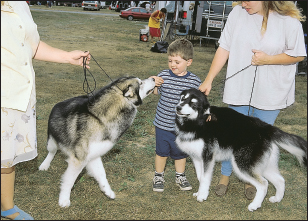
Well-socialized dogs welcome the opportunity of meeting new dogs and people of all ages. If you plan to show your Malamute, socialization is crucial to your dog’s getting along well on the show grounds.
SEPARATION ANXIETY
Any behaviorist will tell you that separation anxiety is the most common problem about which pet owners complain. It is also one of the easiest to prevent. Unfortunately, a behaviorist usually is not consulted until the dog is a stressed-out, neurotic mess. At that stage, it is indeed a problem that requires the help of a professional.
UNDERSTANDING HOW YOUR DOG TICKS
Dogs do not run on human emotions like love, guilt or spite. They operate on trust and loyalty, or faithfulness, and those are worthy alternatives to what we call love. Dogs don’t understand any human language, but they can learn to make connections if all corrections and praise are immediate. If your dog demolished your rug while you were out, that’s not guilt you’re seeing, but a reaction to your anger. He doesn’t know why you’re angry, but he knows the boss isn’t happy. Dogs are pack animals. They have always lived in a cooperative society. Your dog retains that pack instinct, requiring a leader. You now have that job and the responsibility that goes along with it.
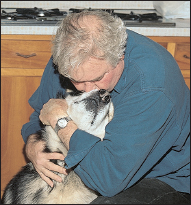
Training the puppy to the fact that people in the house come and go is essential in order to avoid this anxiety. Leaving the puppy in his crate or a confined area while family members go in and out, and stay out for longer and longer periods of time, is the basic way to desensitize the pup to the family’s frequent departures. If you are at home most of every day, make it a point to go out for at least an hour or two whenever possible.
How you leave is vital to the dog’s reaction. Your dog is no fool. He knows the difference between sweats and business suits, jeans and dresses. He sees you pat your pocket to check for your wallet, open your briefcase, check that you have your cell phone or pick up the car keys. He knows from the hurry of the kids in the morning that they’re off to school until afternoon. Lipstick? Aftershave lotion? Lunch boxes? Every move you make registers in his sensory perception and memory. Your puppy knows more about your departures than the FBI. You can’t get away with a thing!
Before you got dressed, you checked the dog’s water bowl and his supply of toys, and turned the radio on low. You will leave him in what he considers his “safe” area, not with total freedom of the house. If you’ve invested in child safety gates, you can be reasonably sure that he’ll remain in the designated area. Don’t give him access to a window where he can watch you leave the house. If you’re leaving for an hour or two, just put him into his crate with a safe toy.
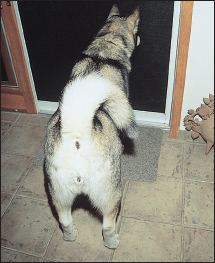
Separation anxiety is a very real problem for dogs. You want your Malamute to be happily occupied in your absence, not waiting by the door.
Now comes the test! You are ready to walk out the door. Do not give your Alaskan Malamute a big hug and a fond farewell. Do not drag out a long goodbye. Those are the very things that jump-start separation anxiety. Toss a biscuit into the dog’s area, call out “So long, pooch” and close the door. You’re gone. Chances are that the dog may bark a couple of times, or maybe whine once or twice, and then settle down to enjoy his biscuit and take a lovely nap, especially if you took him for a nice long walk after breakfast. As he grows up, the barks and whines will stop because it’s an old routine, so why should he make the effort?
When you first brought home the puppy, the come-and-go routine was intermittent and constant. He was put into his crate with a tiny treat. You left (silently) and returned in 3 minutes, then 5, then 10, then 15, then half an hour, until finally you could leave without a problem and be gone for 2 or 3 hours. If, at any time in the future, there’s a “separation” problem, refresh his memory by going back to that basic training.
Now comes the next most important part—your return. Do not make a big production of coming home. “Hi, poochie” is as grand a greeting as he needs. When you’ve taken off your hat and coat, tossed your briefcase on the hall table and glanced at the mail, and the dog has settled down from the excitement of seeing you “in person” from his confined area, then go and give him a warm, friendly greeting. A potty trip is needed and a walk would be appreciated, since he’s been such a good dog.
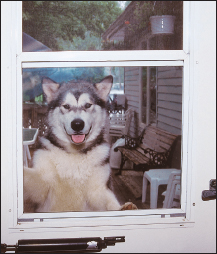
Your Malamute needs plenty of time for outdoor exercise, but he thrives as a family dog, inside the home with the rest of the pack, and he will let you know when he’s ready to come in.
MATTERS OF SEX
For whatever reasons, real or imagined, most people tend to have a preference in choosing between a male and female puppy. Some, but not all, of the undesirable traits attributed to the sex of the dog can be suppressed by early spaying or neutering. The major advantage, of course, is that a neutered male or a spayed female will not be adding to the problem of pet overpopulation.

Dogs can develop unforeseen habits. Some like to be where the action is and are always snooping around.
An unaltered male will mark territory by lifting his leg everywhere, leaving a few drops of urine indoors on your furniture and appliances and outside on everything he passes. It is difficult to catch him in the act, because he leaves only a few drops each time, but it is very hard to eliminate the odor. Thus the cycle begins, because the odor will entice him to mark that spot again.
If you have bought a bitch with the intention of breeding her, be sure you know what you are getting into. She will go through one or two periods of estrus each year, each cycle lasting about three weeks. During those times, she will have to be kept confined to protect your furniture and to protect her from being bred by a male other than the one you have selected. Breeding should never be undertaken to “show the kids the miracle of birth.” Bitches can die giving birth, and the puppies may also die. The dam often exhibits what is called “maternal aggression” after the pups are born. Her intention is to protect her pups, but in fact she can be extremely vicious. Breeding should be left to the experienced breeders, who do so for the betterment of the breed and with much research and planning behind each mating.
Mounting is not unusual in dogs, male or female. Puppies do it to each other and adults do it regardless of sex, because it is not so much a sexual act as it is one of dominance. It becomes very annoying when the dog mounts your legs, the kids or the couch cushions; in these and any other instances of mounting, he should be corrected. Touching sometimes stimulates the dog, so pulling the dog off by his collar or leash, together with a consistent and stern “Off!” command, usually eliminates the behavior.
CHEWING
All puppies chew. All dogs chew. This is a fact of life for canines, and sometimes you may think it’s what your dog does best! A pup starts chewing when his first set of teeth erupts and continues throughout the teething period. Chewing gives the pup relief from itchy gums and incoming teeth and, from that time on, he gets great satisfaction out of this normal, somewhat idle, canine activity. Providing safe chew toys is the best way to direct this behavior in an appropriate manner. Chew toys are available in all sizes, textures and flavors, but you must monitor the wear-and-tear inflicted on your pup’s toys to be sure that the ones you’ve chosen are safe and remain in good condition.
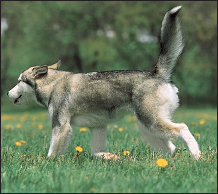
When a dog’s ears are held tightly to his head and his tail is raised, he is not interested in your command. You must learn your dog’s body language.
Puppies cannot distinguish between a rawhide toy and a nice leather shoe or wallet. It’s up to you to keep your possessions away from the dog and to keep your eye on the dog. There’s a form of destruction caused by chewing that is not the dog’s fault. Let’s say you allow him on the sofa. One day he takes a rawhide bone up on the sofa and, in the course of chewing on the bone, takes up a bit of fabric. He continues to chew. Disaster! Now you’ve learned the lesson: dogs with chew toys have to be either kept off furniture and carpets, carefully supervised or put into their confined areas for chew time.
The wooden legs of furniture are favorite objects for chewing. The first time, tell the dog “Leave it!” (or “No!”) and offer him a chew toy as a substitute. But your clever dog may be hiding under the chair and doing some silent destruction, which you may not notice until it’s too late. In this case, it’s time to try one of the foul-tasting products, made specifically to prevent destructive chewing, that is sprayed on the objects of your dog’s chewing attention, making the forbidden object taste bitter and undesirable to chew. These products also work to keep the dog away from plants, trash, etc. It’s even a good way to stop the dog from “mouthing” or chewing on your hands or the leg of your pants. (Be sure to wash your hands after the mouthing lesson!) A little spray goes a long way.

THE CRAZIES
The dog that is hyperactive may be demonstrating normal behavior for his breed, in which case you should have known what you were getting into. An abundance of exercise—both physical and mental—will help expend his energy and prevent his crazy behavior.
DIGGING
Digging is another natural and normal doggy behavior. Wild canines dig to bury whatever food they can save for later to eat. (And you thought we invented the doggy bag!) Burying bones or toys is a primary cause of digging. Dogs also dig to get at interesting little underground creatures like moles and mice. In summer, they dig to get down to cool earth. In winter, they dig to get beneath the cold surface to warmer earth.
The solution to the last two is easy. In the summer, provide a bed that’s up off the ground and placed in a shaded area. In the winter, the dog should either be indoors to sleep or given an adequate insulated doghouse outdoors. To understand how natural and normal this is, you have only to consider the Nordic breeds of sled dog who, at the end of the run, routinely dig beds for themselves in the snow. It’s the nesting instinct. How often have you seen your dog go round and round in circles, pawing at his blanket or bedding before flopping down to sleep?
Domesticated dogs also dig to escape, and that’s a lot more dangerous than it is destructive. A dog that digs under the fence is the one that is hit by a car or becomes lost. A good fence to protect a digger should be set 10 to 12 inches below ground level, and every fence needs to be routinely checked for even the smallest openings that can become possible escape routes.
Catching your dog in the act of digging is the easiest way to stop it, because your dog will make the “one-plus-one” connection, but digging is too often a solitary occupation, something the lonely dog does out of boredom. Catch your young puppy in the act and put a stop to it before you have a yard full of craters. It is more difficult to stop if your dog sees you gardening. If you can dig, why can’t he? Because you say so, that’s why! Some dogs are excavation experts, and some dogs never dig. However, when it comes to any of these instinctive canine behaviors, never say “never.”
JUMPING UP
Jumping up is a device of enthusiastic, attention-seeking puppies, but adult dogs often like to jump up as well, usually as a form of canine greeting. This is a controversial issue. Some owners wouldn’t have it any other way! They encourage their dogs, and the owners and dogs alike enjoy the friendly physical contact. Some owners think that it’s cute when it comes from a puppy, but not from an adult.
CURES FOR COMMON BOREDOM
Dogs are social animals that need company. Lonely and tied-out dogs bark, hoping that someone will hear them. Prevent this from happening by never tying your dog out in the yard and always giving him the attention that he needs. If you don’t, then don’t blame the dog. Bored dogs will think up clever ways to overcome their boredom. Digging is a common diversion for a dog left alone outside for too long. The remedy is to bring him indoors or put a layer of crushed stone in his confined outdoor area. If you catch him in the act of “gardening,” it requires immediate correction. Keep your dog safe by embedding the fencing a foot or more below ground level to foil a would-be escape artist.
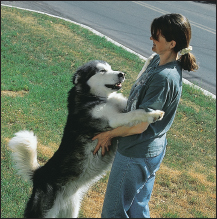
Adult Malamutes are too heavy to jump up to say hello. Train your Malamute as a puppy not to jump up and encourage him to greet you with “four on the floor”…four paws, that is!
Conversely, there are those who consider jumping up to be one of the worst kinds of bad manners to be found in a dog. Among this group inevitably are bound to be some of your best friends. There are two situations in which your dog should be restrained from any and all jumping up. One is around children, especially young children and those who are not at ease with dogs. The other is when you are entertaining guests. No one who comes dressed up for a party wants to be groped by your dog, no matter how friendly his intentions or how clean his paws.
The answer to this one is relatively simple. If the dog has already started to jump up, the first command is “Off,” followed immediately by “Sit.” The dog must sit every time you are about to meet a friend on the street or when someone enters your home, be it child or adult. You may have to ask people to ignore the dog for a few minutes in order to let his urge for an enthusiastic greeting subside. If your dog is too exuberant and won’t sit still, you’ll have to work harder by first telling him “Off” and then issuing the down/stay command. This requires more work on your part, because the down is a submissive position and your dog is only trying to be super-friendly. A small treat is expected when training for this particular down.
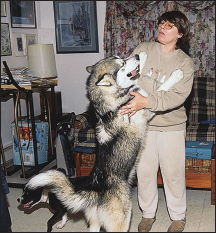
While you may enjoy a hug from your Malamute, not everyone who comes into your home will appreciate such a greeting.
LOOK AT ME WHEN I SPEAK TO YOU
Your dog considers direct eye contact as a sign of dominance. A shy dog will avoid looking at you; a dominant dog will try to stare you down. What you want is for your dog to pay attention when you speak, and that doesn’t necessarily involve direct eye contact. In dealing with a problem dog, avert your gaze momentarily, return to face the dog and give an immediate down command. Show him that you’re the boss.
If you have a real pet peeve about a dog’s jumping up, then disallow it from the day your puppy comes home. Jumping up is a subliminally taught human-to-dog greeting. Dogs don’t greet each other in this way. It begins because your puppy is close to the ground and he’s easier to pet and cuddle if he reaches up and you bend over to meet him halfway. If you won’t like it later, don’t start it when he is young, but do give lots of praise and affection for a good sit.
BARKING
Here’s a big, noisy problem! Telling a dog he must never bark is like telling a child not to speak! Consider how confusing it must be to your dog that you are using your voice (which is your form of barking) to teach him when to bark and when not to! That is precisely the reason not to “bark back” when the dog’s barking is annoying you (or your neighbors). Try to understand the scenario from the dog’s viewpoint. He barks. You bark. He barks again, you bark again. This “conversation” can go on forever!
The first time your adorable little puppy said “Yip” or “Yap, you were ecstatic. His first word! You smiled, you told him how smart he was—and you allowed him to do it. So there’s that one-plus-one thing again, because he will understand by your happy reaction that “Mr. Alpha loves it when I talk.” Ignore his barking in the beginning, and allow it, but don’t encourage barking during play. Instead, use the “put a toy in it” method to tone it down. Add a very soft “Quiet” as you hand off the toy. If the barking continues, stand up straight, fold your arms and turn your back on the dog. If he barks, you won’t play, and you should follow the same rule for all undesirable behavior during play.
QUIET DOWN!
If your dog barks excessively, don’t bark back. Yelling at him only encourages him to keep it up. Barking at the garbage truck makes perfect sense to the dog—that man is stealing your garbage! When the garbage truck leaves, that spells success to the dog: he has scared away the garbage man with his bark! Pick a command word, something like “Quiet” or “No Bark,” to stop his barking. The second he stops, tell him “Good dog” and toss him a toy.
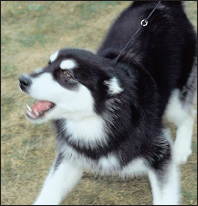
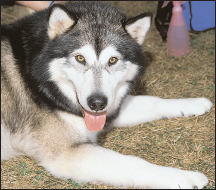
Every Malamute’s personality is different. Generalizations can be made about the breed’s overall temperament, but each dog is an individual with his own likes and dislikes.
Dogs bark in reaction to sounds and sights. Another dog’s bark, a person passing by or even just rustling leaves can set off a barker. If someone coming up your driveway or to your door provokes a barking frenzy, use the saturation method to stop it. Have several friends come and go every three or four minutes over as long a period of time as they can spare (it could take a couple of hours). Attach about a foot of rope to the dog’s collar and have very small treats handy. Each time a car pulls up or a person approaches, let the dog bark once (grab the rope if you need to physically restrain him), say “Okay, good dog,” give him a treat and make him sit. “Okay” is the release command. It lets the dog know that he has alerted you and tells him that you are now in charge. That person leaves and the next arrives, and so on and so on until everyone—especially the dog—is bored and the barking has stopped. Don’t forget to thank your friends. Your neighbors, by the way, may be more than willing to assist you in this parlor game.
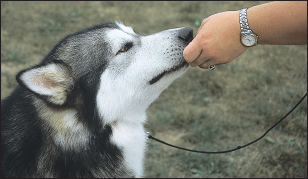
An important part of training is the reward. A small treat, along with your praise, is all it takes to let your dog know he is behaving properly.
Excessive barking outdoors is more difficult to keep in check because, when it happens, he is outside and you are probably inside. A few warning barks are fine, but use the same method to tell him when enough is enough. You will have to stay outside with him for that bit of training.
There is one more kind of vocalizing which is called “idiot barking” (from idiopathic, meaning of unknown cause). It is usually rhythmic or a timed series of barks. Put a stop to it immediately by calling the dog to come. This form of barking can drive neighbors crazy and commonly occurs when a dog is left outside at night or for long periods of time during the day. He is completely and thoroughly bored! A change of scenery may help, such as relocating him to a room indoors when he is used to being outside. A few new toys or different dog biscuits might be the solution. If he is left alone and no one can get home during the day, a noontime walk with a local dog-sitter would be the perfect solution.
FOOD-RELATED PROBLEMS
We’re not talking about eating, diets or nutrition here, we’re talking about bad habits. Face it. All dogs are beggars. Food is the motivation for everything we want our dogs to do and, when you combine that with their innate ability to “con” us in order to get their way, it’s a wonder there aren’t far more obese dogs in the world.
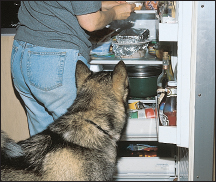
The refrigerator is a source of temptation for every dog. Often dogs will react when they hear the refrigerator door being opened and come into the kitchen to investigate.
Who can resist the bleeding-heart look that says “I’m starving,” or the paw that gently pats your knee and gives you a knowing look, or the whining “please” or even the total body language of a perfect sit beneath the cookie jar. No one who professes to love his dog can turn down the pleas of his clever canine’s performances every time. One thing is for sure, though: definitely do not allow begging at the table. Family meals do not include your dog.
Control your dog’s begging habit by making your dog work for his rewards. Ignore his begging when you can. Utilize the obedience commands you’ve taught your dog. Use “Off” for the pawing. A sit or even a long down will interrupt the whining. His reward in these situations is definitely not a treat! Casual verbal praise is enough. Be sure all members of the family follow the same rules. There is a different type of begging that does demand your immediate response and that is the appeal to be let (or taken) outside! Usually that is a quick paw or small whine to get your attention, followed by a race to the door. This type of begging needs your quick attention and approval. Of course, a really smart dog will soon figure out how to cut you off at the pass and direct you to that cookie jar on your way to the door! Some dogs are always one step ahead of us.
FOOD GUARDING
A dog’s guarding his dinner dish is totally unacceptable behavior. If your dog starts to exhibit food-guarding tendencies, prevent them by putting part of his food in the dish and picking up the dish when he’s finished. Replenish the dish, make him sit and offer him some food from your hand, and then put the dish down. Repeat!
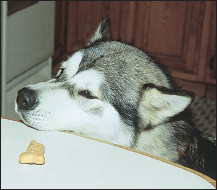
Never feed your Malamute from the table, as this will encourage impolite behavior where food is concerned. If it’s within reach, he will think it’s his.
Stealing food is a problem only if you are not paying attention. A dog can’t steal food that is not within his reach. Leaving your dog in the kitchen with the roast beef on the table is asking for trouble. Nothing idiopathic about this problem! Putting cheese and crackers on the coffee table also requires a watchful eye to stop the thief in his tracks. The word to use (one word, remember, even if it’s two words pronounced as one) is “Leave it!” Instead of preceding it with yet another “No,” try using a guttural sound like “Aagh!” That sounds more like a warning growl to the dog and therefore has instant meaning.
Canine thieves are in their element when little kids are carrying cookies in their hands! Your dog will think he’s been exceptionally clever if he causes a child to drop a cookie. Bonanza! The easiest solution is to keep dog and children separated at snack time. You must also be sure that the children understand that they must not tease the dog with food—his or theirs. Your dog does not mean to bite the kids, but when he snatches at a tidbit so near the level of his mouth, it can result in an unintended nip.

This Malamute is faithful friend and protector of the young members of his pack, including a Shiba Inu puppy, a fellow Nordic breed that hails from Japan.
EATING EXCREMENT
The unpleasant subject of dogs’ eating their own feces, known as coprophagia, can be dealt with relatively easily even though no one is exactly sure why dogs do this. Some say it is primordial, while others feel that it indicates a lack of something in the diet (but there’s no agreement as to what that “something” is). Unless the dog has worms, feces eating cannot make him sick, but that is no reason to allow it to continue. There are products said to alleviate the problem, but check with your vet before adding anything to your puppy’s diet. Sprinkling hot pepper on the feces is an after-the-fact solution. Prevention is the better way to go.
When you housetrained your dog, you took him outside on a leash and stayed with him until he did his business. Afterward, you moved him away or took him back indoors while you went back and cleaned up the feces. You were not giving him any opportunity to indulge in this strange canine habit. Now that your dog goes outside alone, watch to see that it doesn’t start. At his first sign of interest in his own excrement, or that of any other animal, give him a sharp “No! Leave it!” and then bring the dog indoors so you can do your clean-up job. To clean up after your dog on the street, use a plastic bag over your hand to pick up the feces. In your yard, a “poop-scoop” is the easiest answer.
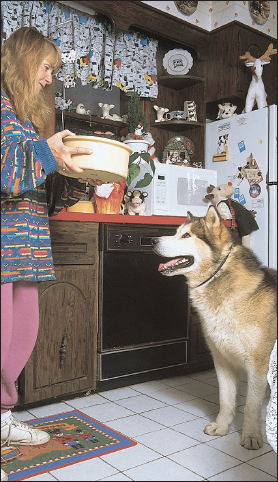
Owners can reinforce their Alpha roles as well as incorporate some training practice by making their dogs wait for their food. This is recommended by many top trainers and behaviorists.
Cat feces entice many dogs, possibly because they have a different, often fishy, odor. If you have cats, look into the litter boxes that are made with narrow tunnel entrances to deter all but the most insistent (and smallest) of dogs. Keep the litter clean and the box in a spot that’s inaccessible to your dog.